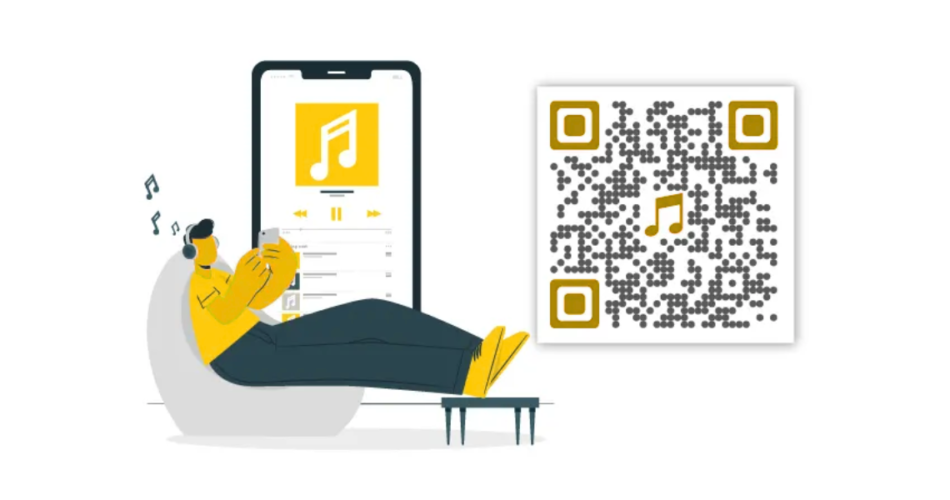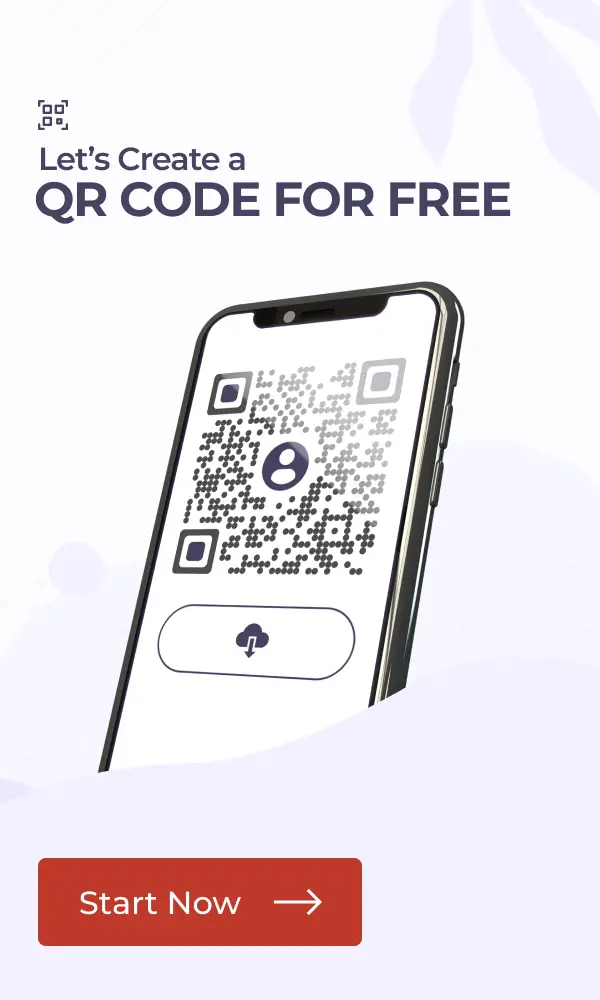In a nutshell: A QR Code for songs or playlists makes sharing music effortless; one scan replaces messy links. These QR Codes work across platforms like Spotify, Apple Music, and YouTube. Artists, brands, and fans can use QR Codes to boost discovery, engagement, and streams. Dynamic QR Codes allow updates, tracking, and multi-platform linking.
Sharing music online is simple. All you have to do is drop a link. But what if you want to share your songs or playlists through print media like posters, flyers, or merchandise? That’s where the real challenge begins.
A Spotify song name or YouTube link printed on paper is long, clunky, and almost impossible for someone to type without making a mistake. This friction often stops people from checking out your music (especially new music/artists).
QR Codes solve this problem. With a single scan, listeners can instantly open a track, playlist, or album on their phones. No typing, no hunting for the right app.
That’s why artists, venues, and even big brands are printing QR Codes on album covers, event posters, and product packaging to connect the offline and online music worlds.
Even Spotify’s own team says that their custom codes, which function exactly like QR Codes, “make sharing music easier than ever, whether it’s on a poster, an album cover, or even a coffee cup.” (source: Spotify Newsroom)
According to Grand View Research, the music streaming market was valued at USD $46.66 billion in 2024 and is expected to more than double to around USD $108.39 billion by 2030.
It’s no surprise that QR Codes are becoming a powerful tool in music promotion. Artists use them on merch and posters, brands tie them into campaigns, and fans share playlists at parties with a quick scan.
In short, QR Codes bring music discovery into the physical world, making print media interactive and engaging.
A. How to create a QR Code for songs and playlists?
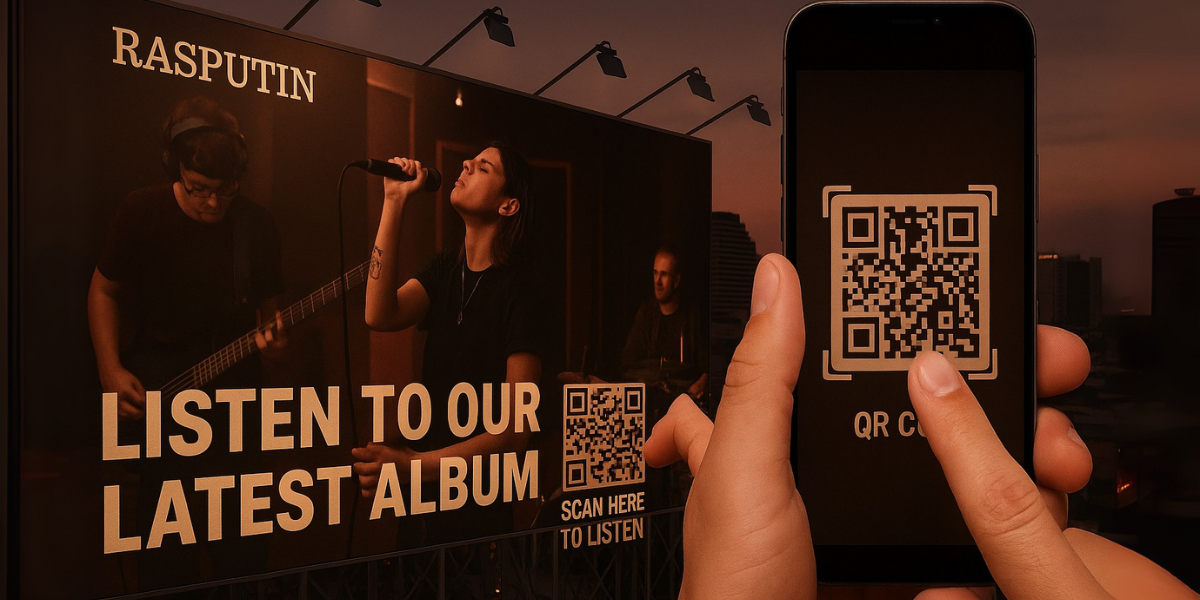
Making a QR Code for music takes just a few minutes. Here’s how you can do it:
Step 1: Choose what you want to share
Decide whether you’re sharing:
- A single song (Spotify track, YouTube video, MP3 file)
- A playlist or album (Spotify/Apple/YouTube playlist link)
- A landing page that lists all platforms (so fans can choose their favorite service), this one is usually a dynamic QR Code, which generally requires a subscription or paid plan
Pro tip: If you want flexibility, create a dynamic QR Code that lets you update or change links later. Don’t worry, I’ll tell you exactly how you can create one later in the article.
Step 2: Copy the link
- On Spotify/Apple Music/YouTube: right-click the song or playlist → “Copy Link”
- For MP3 or hosted audio files: copy the direct file URL
- If using a landing page, copy that URL instead
Step 3: Go to a reliable QR Code generator
Head to a reliable tool like Scanova’s QR Code Generator.
- Select “Website URL” or “Audio File” as your QR Code type
- Paste in the link you copied
Step 4: Customize your QR Code (optional)
Make your QR Code stand out with:
- Colors that match your album, poster, or brand style
- Logos (artist/band logo, event branding)
- Frames and CTA text like “Scan to Listen” or “Play Now”
A custom-designed QR Code attracts more scans than a traditional black and white one.
Step 5: Generate and test it
- Preview and test the QR Code on both iOS and Android devices
- Check that the song or playlist opens smoothly
Step 6: Share your QR Code
- Add it to posters, flyers, album covers, or merch
- Share it in emails, social media, or event tickets
- Place it anywhere your audience will naturally engage
B. Types of QR Codes for songs and playlists
When it comes to sharing music, different situations call for different QR Codes. Here are the main options and when to use them:
1. QR Code for a single song
This QR Code links straight to one track, either on Spotify, or Apple Music, or YouTube, or any other streaming app.
Best for: New single releases, teasers, or promoting one song at a time.
Why it helps: Instead of asking fans to search manually, they can scan and listen in seconds.
Real example: Independent artists often add QR Codes to posters or stickers so people who see them on the street can instantly play the track.
How to do it: Copy the song’s link from your streaming app → Go to Scanova’s free QR Code Generator → choose the “Website URL” or “Audio QR Code” category → paste the link → download.
2. QR Code for a playlist or album
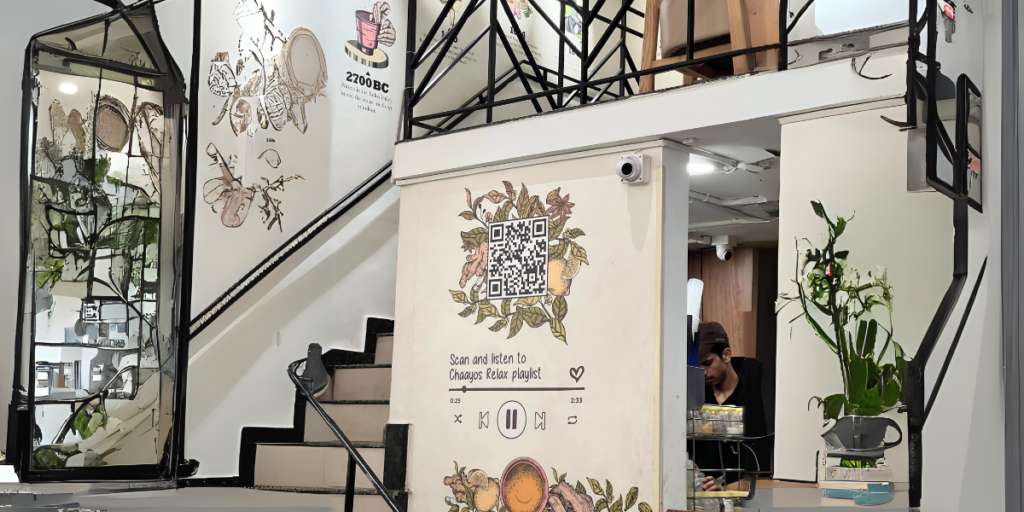
This QR Code connects to an entire playlist or full album.
Best for: DJs, music curators, or brands that want to share a mood or theme through multiple songs.
Why it helps: It saves time, and you don’t need to share each link separately.
Real example: Many cafés and bars add QR Codes to menus that open their “in-store playlist,” letting customers save and follow it.
How to do it: Copy the playlist’s link from your streaming app → Go to Scanova’s free QR Code Generator → choose the “Website URL” or “Audio QR Code” category → paste the link → download.
3. QR Code for an MP3 file or hosted audio
Not every musician has their work on streaming platforms. If you’ve recorded a song but only have the file (MP3, WAV, etc.), an Audio QR Code is the easiest way to share it.
Best for: Upcoming artists, podcasters, or teachers who want to share recordings outside major platforms.
Example: Think of this as the modern-day mixtape. An upcoming artist can print Audio QR Codes on flyers and hand them out on the street and people can scan and instantly listen to the track.
How to do it: Upload your audio file (or link to Dropbox/Google Drive) → Go to Scanova’s “Audio QR Code” category → Customize and download.
This category supports popular audio formats such as MP3, WAV, AAC, and M4A, and lets users upload up to 20 files.
To generate and download the QR Code, you’ll need to sign up for Scanova’s 14-day free trial. After the trial, you can continue with one of Scanova’s affordable pricing plans based on your needs.
4. QR Code for a multi-platform landing page
A single QR Code can lead to a landing page showing all streaming options, Spotify, Apple Music, YouTube, etc.
Best for: Artists and brands who know their audience uses different apps.
Why it helps: One scan works for everyone, no matter which app they prefer.
Real example: Brands like Coca-Cola have used QR Codes on packaging that lead to playlists available across platforms, so fans can choose their service.
How to do it: Go to Scanova’s Custom Page QR Code category. This allows you to create a mobile-friendly landing page that works like a mini website.
You can add buttons for Spotify, Apple Music, YouTube, SoundCloud, or any other streaming service.
You can even include text, images, and a custom background to match your branding. When someone scans the QR Code, they don’t just see one link; they see all your options neatly organized on a single page, and they can choose their preferred platform with one tap.
This is especially useful if your audience uses different apps and you don’t want to exclude anyone. And since it’s a dynamic QR Code, you can edit or update the links anytime without reprinting the code.
Note: Dynamic QR Codes require an ongoing subscription or paid plan.
5. QR Code for campaigns or extras
You can also use the same Custom Page QR Code category to give fans more than music, like videos, behind-the-scenes clips, or exclusive tracks.
Best for: Marketing campaigns, special promotions, or fan engagement.
Why it helps: Builds a stronger connection with the audience by offering something extra.
Real example: Spotify Codes are often printed on posters and merch, letting fans unlock curated playlists or artist extras.
In short: If your goal is flexibility, go with a dynamic QR Code. That way, you can update the link (swap playlists, change songs, add extras) without ever changing the printed code.
C. Benefits of using QR Codes for songs and playlists
QR Codes do more than just replace a copy-paste link. They make music sharing smoother, smarter, and more engaging for both listeners and creators.
1. Share music instantly
Instead of asking someone to search for your track, a QR Code takes them straight there. One scan, and the music starts playing.
2. Works across platforms
Not everyone uses Spotify. Some prefer Apple Music, YouTube, or Amazon Music. With a dynamic QR Code, you can link to a landing page showing all platforms, so fans choose what works for them.
3. Cost-effective and flexible
Printing new posters or flyers every time your playlist changes is expensive. With a dynamic QR Code, you just update the link behind it. The same printed code still works, saving time and money.
4. Track engagement
Want to know how many people actually scanned your code? Dynamic QR Codes let you track scans by time, location, and device. Musicians and brands can measure real-world impact, just like online analytics.
5. Add more than music
A QR Code doesn’t have to stop at a playlist. You can include:
1. Behind-the-scenes videos: Upload your video to YouTube or Vimeo, then embed the link as a clickable button or preview on your Custom Page. Fans scan and instantly watch exclusive footage.
2. Tour dates: Use the text section of the Custom Page to list your upcoming shows with dates and venues. You can also add links to ticketing platforms so fans can book right away.
3. Lyrics or stories behind the songs: Paste the full lyrics in the description box or add short background notes about each track in the text blocks. You can also style the page with headings, separators, and custom colors to make it match your album theme.
4. Exclusive fan content: Share special files like demos, wallpapers, or discount coupons by linking them through Google Drive, Dropbox, or your website. Add those links as buttons on the Custom Page.
Because this is a dynamic QR Code, you can edit and refresh the content anytime with new videos, fresh tour dates, or additional stories, without changing the printed code.
6. Create a polished fan experience
QR Codes aren’t just functional; they look professional when designed well. Add colors, frames with CTAs like “Scan to Listen”, or your logo, and the code becomes part of your album cover, poster, or merch design.
QR Codes don’t just make sharing music easier; they make it smarter, with flexibility, insights, and fan engagement that old-school links can’t match.
D. Use cases and real-world examples of song QR Codes
QR Codes for songs aren’t just convenient in theory; they’re already being used by artists and global brands to drive streams, engagement, and fan connection. Here are some powerful examples:
1. Artists sharing singles and albums
Musicians often use QR Codes on posters, flyers, or even merch to send fans directly to their latest release.
Spotify has leaned into this trend with Spotify Codes, which allow instant sharing of tracks, albums, or playlists in print or digital form (source: Spotify Codes).
2. Coca-Cola’s “Bestie Mode” with Oreo
In 2023, Coca-Cola and Oreo launched a campaign where QR Codes on packaging linked to personalized Spotify playlists.
By scanning the code, users could create a shared playlist with a friend based on their music tastes, turning a product into a social music experience (source: Consumer Goods Technology).
3. Lyric bottles in China
Coca-Cola previously printed popular song lyrics on bottles and paired them with QR Codes.
Scanning unlocked 15-second song clips that people could share on social platforms like WeChat, blending offline packaging with mobile music sharing (source: Marketing Dive).
4. Coke Studio’s AI-powered campaign
As part of its “Real Magic” campaign, Coca-Cola created AI-styled QR Codes that linked directly to exclusive Coke Studio music video content.
These QR Codes appeared in stadiums, theaters, and out-of-home ads, encouraging live audiences to scan and engage (source: Human Driven AI).
5. Venues and cafés sharing playlists
Many cafés and bars now include QR Codes on menus or table tents that link to the playlist currently playing in the venue.
Customers can save it instantly, extending the vibe beyond the store and reinforcing brand identity.
6. Festivals and live events
Music festivals often use QR Codes on tickets, wristbands, or posters to link to official playlists.
This builds excitement before the event, helps attendees discover performing artists, and keeps engagement alive long after the event ends.
7. Exclusive fan experiences
Some artists use QR Codes to unlock hidden tracks, behind-the-scenes videos, or tour announcements.
For example, merch can come with a scannable code that provides buyers with access to unreleased demos, adding value and building loyalty.
E. Design & placement best practices for album QR Codes
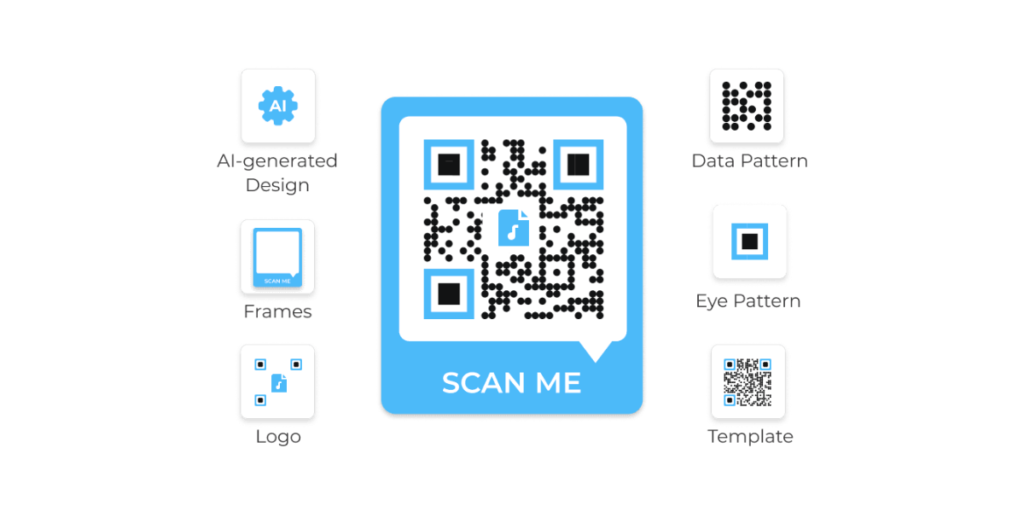
1. Keep design simple
- Use colors or logos that match your album art or brand
- Add a short CTA like “Scan to Listen” so people know what happens
- Always test for contrast and scannability, and remember clarity matters more than decoration
2. Placement tips that work
- Album covers & posters: Great for promoting singles or albums, fans scan right off the artwork
- Merchandise: Add QR Codes to T-shirts, hoodies, or stickers so fans can unlock playlists or exclusive tracks
- Live events: Place codes on stage screens, wristbands, or flyers handed out at concerts and festivals
- Cafés & bars: Print on menus, table tents, or walls to let customers save the venue’s playlist
- Packaging: Brands can put QR Codes on cans, bottles, or product labels that link to mood-based playlists (like Coca-Cola’s campaigns)
- Social media: Share QR Codes digitally in posts, stories, or newsletters for quick access
The goal: put the QR Code where your audience already is, whether that’s holding a product, looking at a poster, or scrolling through social.
F. FAQs: QR Codes for songs
1. How do I make a QR Code for a song or playlist?
Copy the link to your song or playlist (Spotify, Apple Music, YouTube, or MP3) → paste it into a QR Code generator → customize → download and share.
2. Can I use a QR Code for both songs and playlists?
Yes. A QR Code can link to a single track, a full playlist, or even a landing page with multiple platform options.
3. Do QR Codes for songs work across all music apps?
Yes. You can create a dynamic QR Code that opens a landing page with links to Spotify, Apple Music, YouTube, and more, so listeners choose their app.
4. Can I track how many people scan my music QR Code?
Yes, with dynamic QR Codes. You can see scans by time, location, and device, which is helpful for artists and brands measuring campaign performance.
5. Where should I put a QR Code for music?
On posters, album covers, merch, event tickets, menus, packaging, or digital channels like social media and email. Anywhere fans interact with your music or brand.
Conclusion: Make music sharing effortless with QR Codes
In a world where streaming is everywhere, the challenge isn’t access; it’s making sharing simple. QR Codes solve that by turning songs, playlists, and albums into something anyone can open with a single scan.
From artists promoting new singles to brands adding playlists on packaging, QR Codes make music more accessible, more interactive, and more engaging.
The best part? With dynamic QR Codes, you can update links anytime, track engagement, and design codes that match your album art, posters, or merch. It’s a smarter, more flexible way to connect music with listeners.
If you’re ready to try it, explore Scanova’s QR Code Generator. You’ll get powerful customization, real-time analytics, and dynamic editing—all in one easy platform.
👉 Create your music QR Code with Scanova and make sharing your songs as seamless as listening to them.
